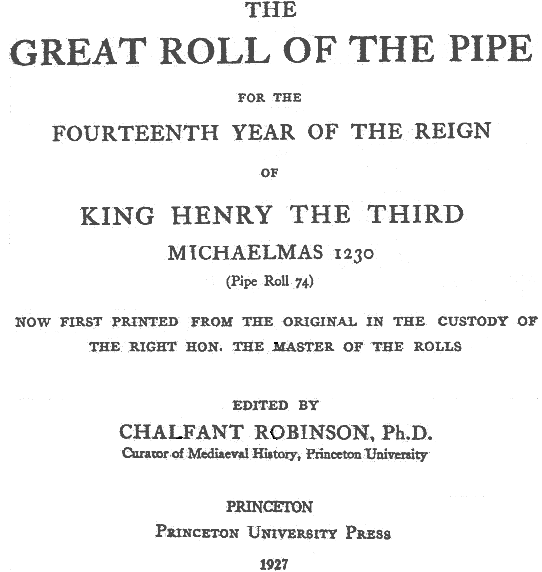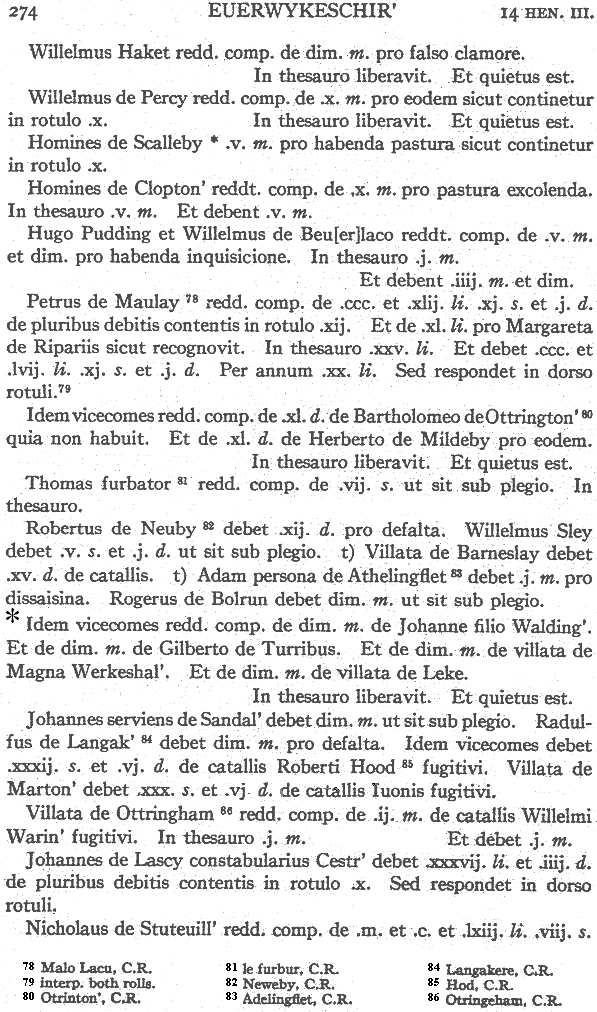Hobbehod
In July of 1225, royal justices headed by Robert de Lexington held assizes at York. The penalties for various persons were put in charge at the Exchequer in 1226. One such record reads: Idem vicecomes debet xxxij. s. et. vj. d. de catallis Roberti Hod fugitivi. The sheriff (of Yorkshire) owes 32s 6d of the chattels of Robert Hod fugitive. This was discovered by L. V. D. Owen and published as ‘Robin Hood in the Light of Research’ in The Times, Trade and Engineering Supplement, xxxviii, no 864 (new series), in February, 1936, p. xxix. Owen states that ‘the position of the entry among others which imply the West Riding of Yorkshire is also interesting’, he goes on to say ‘this Robin Hood is, further, an exact contemporary of the Randolph earl of Chester who figures in the celebrated line of Langland’s Piers Plowman. He also comes into the famous ‘ryme’ of Fulk fitz Warin’. David Crook, from the Public Records Office, informs us that ‘The name appears in the Yorkshire account in nine successive pipe rolls from 1226 to 1234, six times as Robert Hod, once (in 1229-30) as Robert Hood, and twice (in 1227 and 1228) as Hobbehod. In 1227 ‘St Peter’ is inserted in the margin of the roll next to his name, and again in 1234, when the name is also preceded by a cross; in the following year it has been removed from the roll’.(1) The cross could suggest that the debt had been written off, or finally paid, although this could be a signal that a summons was put in place. The historian J. C. Holt (Robin Hood, 1982, p. 54) mentions the marginal note in the 1227 entry, and declares that this debt was due from the Liberty of St Peter’s York, and that ‘Hobbehod or Robert Hod must therefore have been a tenant of the archbishopric’. It has more recently been suggested that the debt involved the Dean and Chapter.(2)
There have been attempts to identify the sheriff involved, and two possibilities were put forward by Holt in 1960: Phillip Mark, sheriff of Nottinghamshire and Derbyshire from 1209 to 1224, and Brian de Lisle, chief forester of Nottinghamshire and Derbyshire from 1209 to 1217, chief justice of the forest from 1221 to 1224 and sheriff of Yorkshire in 1233-4. Holt mentions an even better proposal put forward by Jeffrey Stafford; Eustace of Lowdham, who was sheriff of Yorkshire from 29 April 1225 to 26 May 1226 and then deputy-sheriff until Michaelmas in that year. He was also a forest justice north of Trent in 1226 and in 1232-3 became sheriff of Nottinghamshire. Holt states that ‘It was Eustace who, as deputy-sheriff of Yorkshire, had to collect and account at the Michaelmas Exchequer of 1226 for the penalties imposed by Robert de Lexinton, who sat in judgement on Robert Hode, and for the sale of the chattels of felons and outlaws’. (Holt, Robin Hood, pp. 60-61).
Whatever the case, this Robert Hod was a fugitive, but the plea roll that may have given the details of the charges against him has not survived. Holt believed that as he had fled the jurisdiction of the court, he was an outlaw, but some entries in the rolls actually have ‘utlagii’ (outlaw) instead of ‘fugitivi’ written after the name, and the process is not straightforward, as can be seen in The Ancient Decree of Outlawry. Holt also believed that the choice for the real Robin Hood ‘really lies between Robert Hod, the Yorkshire outlaw of 1225, and some member of the Hood family of Wakefield and its neighbourhood’.
A more recent attempt to identify ‘Hobbehod’ has been made by Robert Lynley, who believes that the penalties imposed on him and others, could have been a result of resistance to perambulations(3)and that Robert Hod de Linton,(4)who appears in Pipe Roll entries of 1241, 1257, and 1263, (see More Robert Hoods) was one and the same person. The Dean and Chapter of the Liberty of St Peter’s (where Hobbehod was probably a tenant) apparently had land holdings at Linton in 1221, as there was a dispute between the Dean and William de Percy over a lay fee.
1. ‘The Sheriff of Nottingham and Robin Hood: The Genesis of the Legend in ‘Thirteenth Century England II, Proceedings of the Newcastle upon Tyne Conference 1987′ ed. P. R. Coss & S. D. LLoyd, 1988.
2. From the research of David Hepworth and Robert Lynley; The Dean and Chapter is the legal corporation and governing body of a cathedral. It consists of the dean, who is chief, and his canons or prebendaries.
3. To walk around a territory such as a parish, manor, or forest, in order to officially assert and record its boundaries.
4. Linton (Wetherby, West Yorkshire) is about twenty miles from Barnsdale.
.

|



